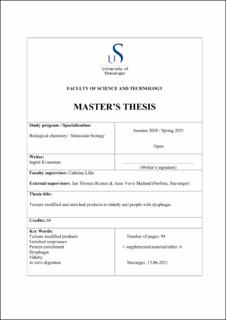| dc.description.abstract | The main aim for this thesis was to develop products with defined texture and viscosity properties for elderly people and dysphagia patients at Stavanger Universitets Sykehus (SUS). Two products were developed: 1) a texture modified cod product and 2) a protein enriched fish soup, both stored frozen (-30 °C) to obtain longer shelf life. The products were enriched with the dairy proteins whey protein concentrate (WPC) and caseinate, and with fish protein hydrolysate (FPH).
The products were characterised in accordance with texture levels in the International Dysphagia Diet Standardisation Initiative (IDDSI). The texture modified products (TMP) produced were between level 5-“minced and moist” and level 6-“soft and bite size”. Texture analysis showed that TMP with a higher total protein content was significantly firmer than non-enriched or less enriched products. Also, the IDDSI fork pressure test of the texture modified products revealed that they got firmer with increasing protein content and with cooling during 15- and 30 min standstill, from eating temperature at 55 °C. Rheology measurements of TMP showed that there could be a correlation between protein content, temperature and storage modulus. High-pressure processing of TMP was tested to see if combination of pressure and chilled storage (4 °C) could give prolonged shelf life. It showed that bacteria survived at 600 MPa for 10 min. The numbers where <1000 bacteria/g, and no growth was observed when the products were stored for 35 days at 4 °C. This indicate that HPP products could have an acceptable safety for 5 weeks at chilled storage. The texture analyses of HPP showed that the firmness changed significantly with different high-pressure treatments and different protein content. Colour analysis showed that the protein enrichment in TMP gave a more yellow product.
The non-enriched soup belonged to IDDSI level 1 at 55 °C, while the low- and high-enriched soup both were at level 3 at 55 °C. The viscosity was not significantly different at 25 °C and 55 °C for the non-enriched soup and measurements showed increased viscosity with increasing protein enrichment. Rheology measurements of the soup showed that at 55 °C, the yield stress increased with increasing protein content and the most viscous soup was the high-enriched at 25 °C. Colour analysis showed that a higher protein enrichment yielded a significantly less light-colored soup product, but not increased yellowness as in TMP.
Digestion of proteins in INFOGEST models showed that protein enrichment gave more protein available for absorption in the intestine for both adults and elderly. Protein enriched products had approximately the same digestibility as non-enriched products. The protein digestibility was higher in the soup than the TMP and the raw material cod fillet. All products showed slightly reduced protein digestibility in the elderly model, mainly due to lower amounts of soluble protein in the intestinal phase.
The pilot products developed in this work showed that it was possible to enrich foods using sustainable fish protein hydrolysate, in addition to dairy proteins. The non-enriched TMP contained 17.4 % protein, the low-enriched contained 18.8 % protein, and the high-enriched contained 20.2 % protein. The soups from pilot production were enriched up to 8 % of protein. The non-enriched soup contained 4 %, and the low-enriched 6 % protein. | |
